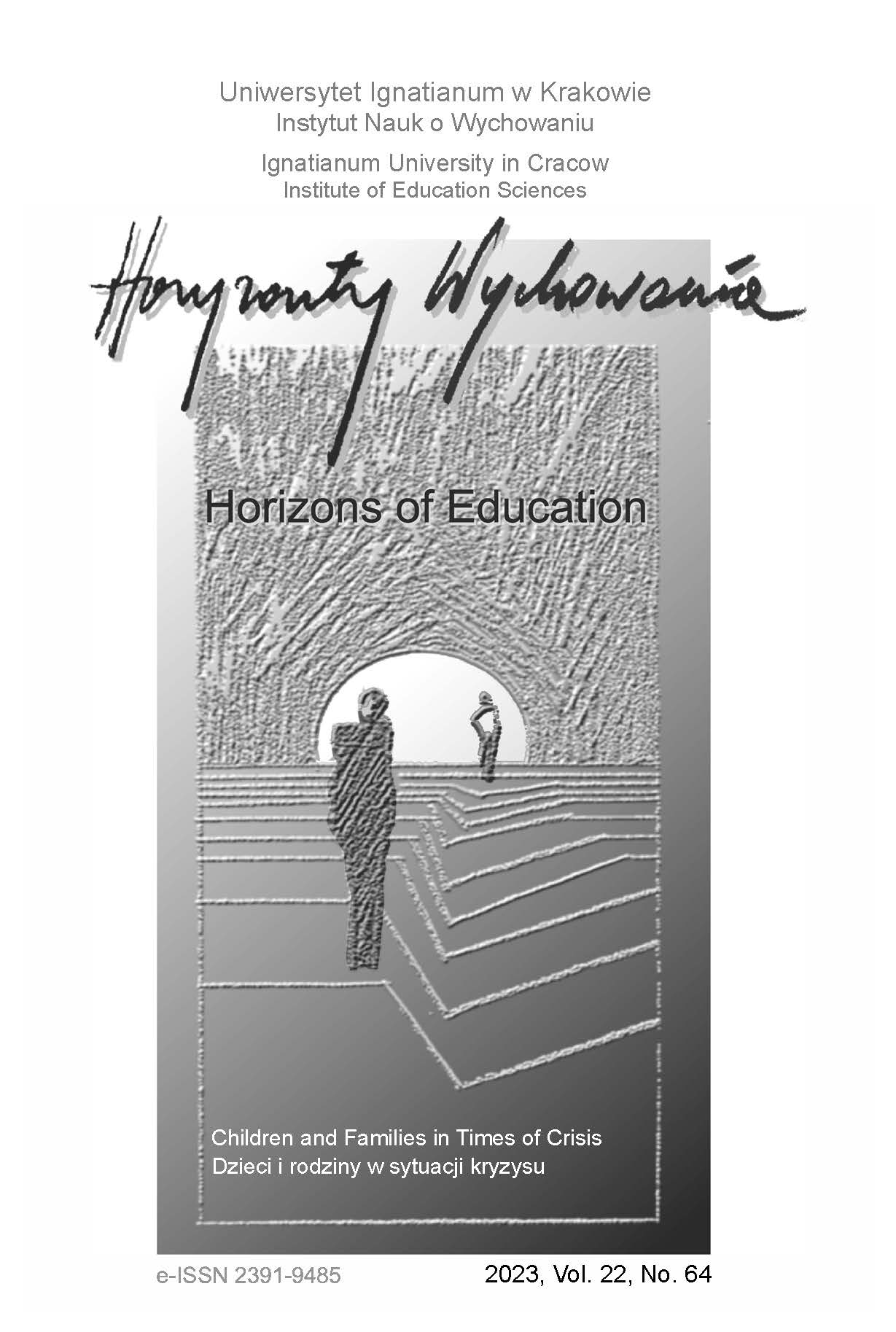Selected Contexts of Family Relations in the Perception of Children Raised in Reconstructed Family Systems Based on the Family Relationship Test Survey
Abstract
RESEARCH OBJECTIVE: In this article, we focused our attention on children’s perception of the image of complex family systems such as patchwork families.
THE RESEARCH PROBLEM AND METHODS: The research problem represents selected aspects of family relationships from the perspective of children belonging to patchwork families. The study was conducted using a qualitative research strategy. The Family Relationship Test was applied and in-depth interviews were conducted with adult members of reconstructed families.
THE PROCESS OF ARGUMENTATION: The crisis within marital relationships is causing an increase in alternative forms of family life. Reconstructed families, also referred to as patchwork families, are becoming more common. They are formed by a couple of adults, at least one or both of whom have children from previous relationships. This complex family structure also includes the biological parents of the children, who remain outside the core system on a daily basis. Creating a new family is a demanding task.
RESEARCH RESULTS: The reconstructed families studied, no matter how well they managed the process of family integration, faced various challenges, including: reconstructing the external and internal boundaries of their families, creating a new family hierarchy, establishing the parental roles of foster parents, dealing with conflicts of loyalty. These processes are shown from the perspective of children belonging to reconstructed family systems.
CONCLUSIONS, RECOMMENDATIONS AND APPLICABLE VALUE OF RESEARCH: Thanks to a study conducted using the Family Relationship Test, we were able to determine the forms of family relationships and affective relations prevailing in the patchwork families studied, as perceived by the children raised in these systems. The results of our analysis may serve as an inspiration for other researchers to explore this area further and for practitioners as a guide in the formation of optimal affective relationships in reconstructed families.
References
Bray, J.H., i Kelley, J. (1999). Stepfamilies: Love, marriage, and parenting in the first decade. Random House.
Golish, T.D. (2003). Stepfamily communication strengths: Understanding the ties that bind. Human Communication Research, 29(1), 41–80.
Hetherington, E.M. (1993). An overview of the Virginia longitudinal study of divorce and remarriage with a focus on early adolescence. Journal of Family Psychology, 7(1), 39–56.
Hetherington, E.M. (1999). Family functioning and the adjustment of adolescent siblings in diverse types of families. Monographs of the Society for Research in Child Development, 64, 1–25.
Hetherington, E.M., i Stanley-Hagan, M.S. (1995). Parenting in divorced and remarried families. W: M. Bornstein (red.), Handbook of parenting (pp. 61–83). Erlbaum.
Jensen, T.M., i Ganong, L.H. (2020). Stepparent–child relationship quality and couple relationship quality: Stepfamily household type as a moderating influence. Journal of Family Issues, 41(5), 589–610.
King, V., Boyd, L.M., i Thorsen, M.L. (2015). Adolescents’ perceptions of family belonging in stepfamilies. Journal of Marriage and the Family, 77(3), 761–774.
Kwak, A. (2000). Rodziny rekonstruowane – problemy i zagadnienia. W: E. Milewska, i A. Szymanowska (red.), Rodzice i dzieci. Psychologiczny obraz sytuacji problemowych (s. 78–99). Centrum Metodyczne Pomocy Psychologiczno-Pedagogicznej Ministerstwa Edukacji Narodowej.
Lewandowska-Walter, A. (2014). Rodzina zrekonstruowana. W: I. Janicka, i H. Liberska (red.), Psychologia rodziny (s. 305–329). Wydawnictwo Naukowe PWN.
Lewandowska-Walter, A., i Błażek, M. (2018). Test relacji rodzinnych TRR. Pracownia Testów Psychologicznych i Pedagogicznych.
Przybył, I. (2020). Dziecko jako atrybut małżeństwa? Społeczno-kulturowe uwarunkowania procesu separacji małżeństwa i rodzicielstwa. W: M. Bieńko, M. Rosochacka-Gmitrzak, i E. Wideł (red.), Obrazy życia rodzinnego i intymności. Książka dedykowana profesor Annie Kwak (s. 223–236). Wydawnictwo Uniwersytetu Warszawskiego.
Skaggs, M.J., i Jodl, K.M. (1999). Adolescent adjustment in nonstepfamilies and stepfamilies. Monographs of the Society for Research in Child Development, 64, 144–160.
Szlendak, T. (2012). Socjologia rodziny. Ewolucja, historia, zróżnicowanie. Wydawnictwo Naukowe PWN.
Visher, E.B., i Visher, J.S. (1993). Remarriage families and stepparenting. W: F. Walsh (red.), Normal family processes (s. 235–253). Guilford Press
Copyright (c) 2022 HORIZONS OF EDUCATION

This work is licensed under a Creative Commons Attribution-NoDerivatives 4.0 International License.
Authors who publish in this journal agree to the following terms:
- Authors retain the copyright to their work while granting the journal the right of first publication. The work will be simultaneously licensed under a CC BY-ND license, which permits others to share the work with proper credit given to the author and the original publication in this journal.
- Authors may enter into additional, non-exclusive agreements for the distribution of the published version of the work (e.g., posting it in an institutional repository or publishing it in another journal), provided that the original publication in this journal is acknowledged.
We allow and encourage authors to share their work online (e.g., in institutional repositories or on personal websites) both before and during the submission process, as this can foster beneficial exchanges and lead to earlier and increased citations of the published work. (See The Effect of Open Access). We recommend using any of the following academic networking platforms:





